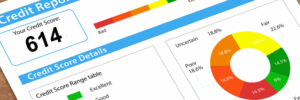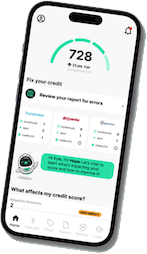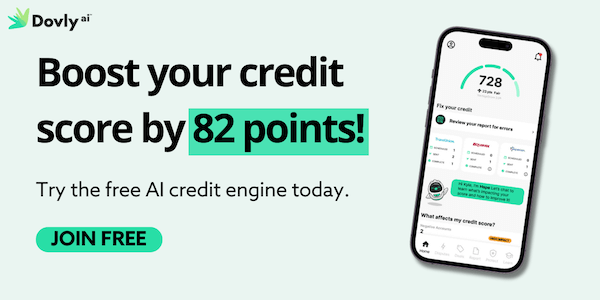614 Credit Score: What It Means and How to Improve It

A 614 credit score falls in the “fair” range, just below average—but it’s far from the end of the road. In this post, we break down what a 614 means in both FICO and VantageScore models, how it affects your credit options, and the smart steps you can take to improve it. Whether you’re rebuilding or just starting out, this guide will help you move toward better rates and stronger financial health.
If you’ve landed here, chances are you’re wondering what a 614 means for your overall credit score. We’ll break it down clearly and practically—so you can take the next steps with confidence and access better financial opportunities.

Is a 614 Credit Score Good or Bad?
A 614 credit rating isn’t the worst-case scenario, but it does fall below average—and it might restrict your access to better options. Think of it as a signal, not a sentence. You’re not starting from scratch—but there’s room to grow.
How FICO and VantageScore Define It
Most lenders use either the FICO® Score or VantageScore® model. Here’s how a 614 stacks up:
- FICO® Score Range: 580–669 = Fair
- VantageScore® Range: 601–660 = Fair, Below 600 = Poor
You’re on the lower edge of Fair. You may still have access to credit products, but with higher rates and less favorable terms.
What Affects a 614 Score?
A 614 score usually reflects patterns in your financial behavior—like how much credit you use, how often you pay on time, or even past setbacks such as bankruptcy. Here’s what could be weighing it down:
Late or Missed Payments
Payment history is a key factor in your score. Just one missed bill can knock your score down and stay on your credit record for years. To improve, set up automatic payments and prioritize paying on time.
High Credit Utilization
Using too much of your available credit—especially revolving credit—hurts your credit scores. Aim to keep your balances under 30% of your credit limit, ideally below 10% if possible.
Limited Credit History or Thin Credit File
If you’re new to credit or only have one or two credit accounts, your credit file may be too “thin” for lenders to trust. A short credit history can drag your score down, even without major mistakes.
Recent Hard Inquiries or New Credit
Opening multiple new accounts in a short time creates hard inquiries on your credit reports, which can ding your score. It also tells lenders you may be overextended or facing financial stress.
What Can You Do With a 614 Credit Score?
A 614 may not unlock access to premium offers, but borrowers aren’t completely locked out either. Lenders review your full financial profile—including income, credit report, and other factors. Showing that you’re a responsible borrower can boost your creditworthiness and help you access better offers—saving you tens of thousands over time.
With that in mind, here’s what’s still on the table:
Credit Cards
While you may not qualify for top-tier rewards cards, a secured credit card can be a smart way to build credit. These cards require a refundable deposit, often in the range of a few hundred dollars, and typically report to all three credit bureaus, helping you establish positive account activity when used responsibly.
Personal Loans
You can still get a personal loan, particularly for debt consolidation or emergency expenses. Prequalifying with a soft credit pull can help you compare offers.
Mortgages or Car Loans
You can access a mortgage or auto loan with a 614, especially through FHA or subprime programs. Lenders review your full financial profile, including income and payment history. Though your interest rate may be higher, a small score boost can save you thousands over time.
How to Improve a 614 Credit Score
A 614 isn’t forever. With the right moves, you could raise your score by dozens of points in just a few months and unlock lower interest rates on everything from credit cards to mortgages. Let’s walk through the key steps.
Make All Monthly Payments On Time
This is the most important habit. Making timely payments is the single most key factor in your overall score—it accounts for the largest portion of your score.
- Set up autopay or calendar reminders to stay on top of bills
- Even one late payment can knock your score down and stay on your credit reports for years
- When you consistently pay on time, you show lenders that you’re reliable and serious about your finances
Lower Your Credit Utilization
If your available balance is nearly maxed out, your score is likely taking a hit. High balances signal risk.
- Aim for low credit utilization—under 30%, but under 10% is even better
- Pay down existing debt instead of opening more lines of credit
- Reducing your usage can have a near-immediate impact on your FICO scores
Add Positive History
Sometimes the issue isn’t what’s wrong—it’s what’s missing. If your credit file is thin or lacks diversity, adding new positive data can help.
- Use tools like Experian Boost to add utility and phone bills to your record and help build credit faster
- Consider a credit builder loan to show steady repayment behavior
- Becoming an authorized user on a seasoned, well-managed card can give your profile a boost
Avoid New Credit Unless Necessary
Every time you apply for credit, a hard inquiry appears—and too many at once can hurt your score.
- Opening new accounts also lowers your average credit age, which affects your score
- Focus on maintaining what you already have while you build a stronger credit foundation
How Long Will It Take to Go From 614 to a Good Credit Score?
Raising a 614 score takes time, but it’s absolutely doable. Many people see progress within 3 to 6 months by consistently paying bills and lowering balances. Bigger jumps—like reaching the 700s—can take closer to a year, depending on your current debt, credit history, and overall profile.
As you build, avoid habits that work against you—like opening too many new accounts, closing older ones (which hurts your credit age), maxing out cards, or taking on new debt without a plan. And steer clear of credit repair scams. Use legit tools like Dovly AI to build your score the right way.

TLDR: A 614 Credit Score Isn’t the End—It’s the Starting Line
A 614 credit score doesn’t define your financial future. Many people start here when building credit or bouncing back from setbacks. By paying bills on time, lowering balances, and avoiding new debt, you can move into the “good” credit range and unlock better financial opportunities.
Dovly AI makes it easier to get there—helping you monitor your credit, dispute errors automatically, and get personalized tips to boost your score and reach your financial goals faster.
Frequently Asked Questions
Can I get approved with a 614 score?
Can I buy a house with a 614 score?
What does it mean if your credit score is 614?
Is 614 a good credit score to buy a car?



